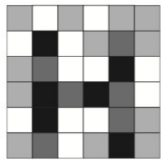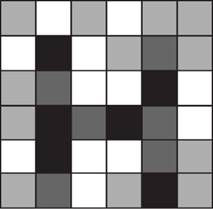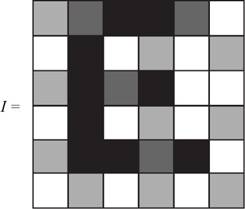
Digital Images A four-level gray scale is shown below.

- (a) Use the gray scale to find a 6 × 6 matrix that digitally represents the image in the figure.

- (b) Find a matrix that represents a darker version of the image in the figure.
- (c) The negative of an image is obtained by reversing light and dark, as in the negative of a photograph. Find the matrix that represents the negative of the image in the figure. How do you change the elements of the matrix to create the negative?
- (d) Increase the contrast of the image by changing each 1 to a 0 and each 2 to a 3 in the matrix you found in part (a). Draw the image represented by the resulting matrix. Does this clarify the image?
- (e) Draw the image represented by the matrix I. Can you recognize what this is? If you don’t, try increasing the contrast.
(a)
To find: The matrix that digitally represent the given figure by using gray scale.
Answer to Problem 49E
The matrix that digitally represents the given figure by using gray scale is
Explanation of Solution
Given:
The given digital image is,

Figure (1)
And gray scale is.

Figure (2)
According to given gray scale 0 represents brightest 1 represents light gray, 2 represents dark gray and 3 represents black.
Tabulate the matrix of dimension
Hence, the matrix that digitally represent the given image is
(b)
To find: A matrix that represents a darken version of the given digital image.
Answer to Problem 49E
A matrix that represents a darken version of the given digital image is
Explanation of Solution
To darken the images add 1 to each of the elements of matrix formed in part (a) except the darkest one that is 3.
From part (a) matrix of given image is
Hence, matrix that represents a darken version of the given digital image is
(c)
To find: The matrix that represents the negative of the image.
Answer to Problem 49E
Hence, matrix that represents the negative of the image in the figure is,
Explanation of Solution
From part (a) matrix of given image is
Reverse the light and the dark to get the negative of the given image, put 0 for 3 and 1 for 2,2 for 1 and 3 for 0. in the matrix formed in part (a).
Hence, matrix that represents the negative of the image in the figure is
(d)
To sketch: The contrast image of the given figure.
Explanation of Solution
From part (a) matrix of given image is
Change each 1 to 0 and 2 to 3 to form a matrix of a given image with increased contrast and element 0 and 3 in the matrix is remain same.
Use this matrix to draw the image of increased contrast with the help of gray scale.

Hence, the image of the given figure with increased contrast is,

Figure (3)
(e)
To sketch: The digital image from the matrix
Explanation of Solution
Draw the image corresponding to the assigned value in the matrix I with the help of gray scale, put white for 0, light gray for 1, dark gray for 2, and black for 3,

Figure (4)
Figure (4) shows the image for given matrix I.
As, image is not recognizable so, change the contrast of the image.
Change each 1 to 0 and 2 to 3 to form a matrix of a given image with increased contrast and element 0 and 3 in the matrix remain same.
Again draw the image according to the given matrix using gray scale.

Figure (5)
The Figure (5) shows that the image is of English alphabet E.
Chapter 10 Solutions
Precalculus: Mathematics for Calculus - 6th Edition
- 53,85÷1,5=arrow_forward3. In the space below, describe in what ways the function f(x) = -2√x - 3 has been transformed from the basic function √x. The graph f(x) on the coordinate plane at right. (4 points) -4 -&- -3 -- -2 4 3- 2 1- 1 0 1 2 -N -1- -2- -3- -4- 3 ++ 4arrow_forward2. Suppose the graph below left is the function f(x). In the space below, describe what transformations are occuring in the transformed function 3ƒ(-2x) + 1. The graph it on the coordinate plane below right. (4 points)arrow_forward
- 1 1. Suppose we have the function f(x) = = and then we transform it by moving it four units to the right and six units down, reflecting it horizontally, and stretching vertically by 5 units. What will the formula of our new function g(x) be? (2 points) g(x) =arrow_forwardSuppose an oil spill covers a circular area and the radius, r, increases according to the graph shown below where t represents the number of minutes since the spill was first observed. Radius (feet) 80 70 60 50 40 30 20 10 0 r 0 10 20 30 40 50 60 70 80 90 Time (minutes) (a) How large is the circular area of the spill 30 minutes after it was first observed? Give your answer in terms of π. square feet (b) If the cost to clean the oil spill is proportional to the square of the diameter of the spill, express the cost, C, as a function of the radius of the spill, r. Use a lower case k as the proportionality constant. C(r) = (c) Which of the following expressions could be used to represent the amount of time it took for the radius of the spill to increase from 20 feet to 60 feet? r(60) - r(20) Or¹(80-30) r(80) - r(30) r-1(80) - r−1(30) r-1(60) - r¹(20)arrow_forward6. Graph the function f(x)=log3x. Label three points on the graph (one should be the intercept) with corresponding ordered pairs and label the asymptote with its equation. Write the domain and range of the function in interval notation. Make your graph big enough to see all important features.arrow_forward
- Find the average value gave of the function g on the given interval. gave = g(x) = 8√√x, [8,64] Need Help? Read It Watch Itarrow_forward3. Mary needs to choose between two investments: One pays 5% compounded annually, and the other pays 4.9% compounded monthly. If she plans to invest $22,000 for 3 years, which investment should she choose? How much extra interest will she earn by making the better choice? For all word problems, your solution must be presented in a sentence in the context of the problem.arrow_forward4 πT14 Sin (X) 3 Sin(2x) e dx 1716 S (sinx + cosx) dxarrow_forward
- Let g(x) = f(t) dt, where f is the function whose graph is shown. 3 y f(t) MA t (a) At what values of x do the local maximum and minimum values of g occur? Xmin = Xmin = Xmax = Xmax = (smaller x-value) (larger x-value) (smaller x-value) (larger x-value) (b) Where does g attain its absolute maximum value? x = (c) On what interval is g concave downward? (Enter your answer using interval notation.)arrow_forward2. Graph the function f(x)=e* −1. Label three points on the graph (one should be the intercept) with corresponding ordered pairs (round to one decimal place) and label the asymptote with its equation. Write the domain and range of the function in interval notation. Make your graph big enough to see all important features. You may show the final graph only.arrow_forwardansewer both questions in a very detailed manner . thanks!arrow_forward
 Calculus: Early TranscendentalsCalculusISBN:9781285741550Author:James StewartPublisher:Cengage Learning
Calculus: Early TranscendentalsCalculusISBN:9781285741550Author:James StewartPublisher:Cengage Learning Thomas' Calculus (14th Edition)CalculusISBN:9780134438986Author:Joel R. Hass, Christopher E. Heil, Maurice D. WeirPublisher:PEARSON
Thomas' Calculus (14th Edition)CalculusISBN:9780134438986Author:Joel R. Hass, Christopher E. Heil, Maurice D. WeirPublisher:PEARSON Calculus: Early Transcendentals (3rd Edition)CalculusISBN:9780134763644Author:William L. Briggs, Lyle Cochran, Bernard Gillett, Eric SchulzPublisher:PEARSON
Calculus: Early Transcendentals (3rd Edition)CalculusISBN:9780134763644Author:William L. Briggs, Lyle Cochran, Bernard Gillett, Eric SchulzPublisher:PEARSON Calculus: Early TranscendentalsCalculusISBN:9781319050740Author:Jon Rogawski, Colin Adams, Robert FranzosaPublisher:W. H. Freeman
Calculus: Early TranscendentalsCalculusISBN:9781319050740Author:Jon Rogawski, Colin Adams, Robert FranzosaPublisher:W. H. Freeman
 Calculus: Early Transcendental FunctionsCalculusISBN:9781337552516Author:Ron Larson, Bruce H. EdwardsPublisher:Cengage Learning
Calculus: Early Transcendental FunctionsCalculusISBN:9781337552516Author:Ron Larson, Bruce H. EdwardsPublisher:Cengage Learning





